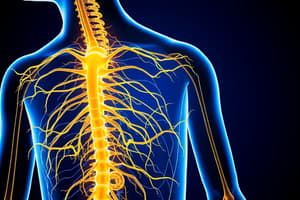Podcast
Questions and Answers
What is a key feature of the autonomic nervous system (ANS) in normal functioning?
What is a key feature of the autonomic nervous system (ANS) in normal functioning?
- It operates mainly during voluntary movements.
- It maintains homeostasis by regulating involuntary body functions. (correct)
- It solely controls sensory input from the environment.
- It exclusively innervates all skeletal muscles.
Which concept best describes a reflex that occurs without conscious thought?
Which concept best describes a reflex that occurs without conscious thought?
- Voluntary reflex
- Conditioned reflex
- Somatic reflex
- Unconditioned reflex (correct)
How do the somatic and visceral systems interact during a reflex action?
How do the somatic and visceral systems interact during a reflex action?
- They both require higher brain functions to coordinate actions.
- Visceral sensations can trigger somatic reactions. (correct)
- They function independently without influencing each other.
- Somatic signals inhibit visceral responses.
Where is autonomic innervation primarily distributed in the body?
Where is autonomic innervation primarily distributed in the body?
What role does osteopathic manipulative treatment (OMM) play in reflex facilitation?
What role does osteopathic manipulative treatment (OMM) play in reflex facilitation?
Flashcards are hidden until you start studying
Study Notes
Autonomic Nervous System (ANS) Features
- The ANS controls involuntary bodily functions such as heart rate, digestion, and respiratory rate.
- It is divided into three main components: sympathetic, parasympathetic, and enteric nervous systems.
- Sympathetic responses prepare the body for 'fight-or-flight,' while parasympathetic responses promote 'rest-and-digest' activities.
- ANS operates subconsciously, integratively responding to internal and external stimuli.
General Reflex Concepts
- Reflexes are automatic responses that involve a sensory input and a motor output, bypassing conscious thought.
- The basic reflex arc consists of a sensory receptor, sensory neuron, integration center (spinal cord), motor neuron, and effector.
- Types of reflexes include monosynaptic (e.g., knee-jerk reflex) and polysynaptic (e.g., withdrawal reflex).
- Reflex testing is a common clinical assessment to evaluate the integrity of the nervous system.
Interplay between Somatic and Visceral Systems
- Somatic system controls voluntary movements of skeletal muscles, whereas visceral system regulates internal organs.
- Afferent pathways from visceral structures can affect somatic responses and vice versa, demonstrating their interconnectedness.
- Pain or dysfunction in visceral organs can manifest as somatic pain (referred pain).
- Coordination between these systems is essential for maintaining homeostasis and responding effectively to stress.
Autonomic Innervation Distribution
- Sympathetic innervation originates from the thoracolumbar region (T1-L2), affecting vasculature, sweat glands, and some internal organs.
- Parasympathetic innervation arises from the craniosacral region (brainstem and sacrum) and primarily impacts digestive processes and resting functions.
- Organs have dual innervation; sympathetic and parasympathetic systems often work antagonistically to fine-tune bodily functions.
- Distribution includes significant areas like the heart, lungs, gastrointestinal tract, and urinary system.
Reflex Facilitation and OMM
- Reflex facilitation refers to the increased sensitivity of reflex pathways often resulting from stress or interference.
- Osteopathic Manipulative Medicine (OMM) techniques aim to restore normal function by addressing neural, muscular, and skeletal systems.
- OMM can enhance neurophysiological responses by decreasing reflex facilitation, promoting balance and function.
- Understanding reflex facilitation enhances clinical assessment and treatment strategies for patients with somatic dysfunctions.
Studying That Suits You
Use AI to generate personalized quizzes and flashcards to suit your learning preferences.




